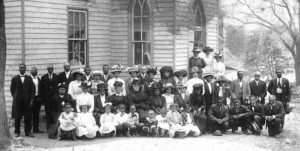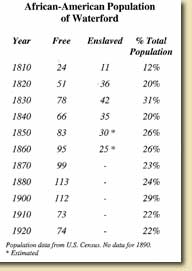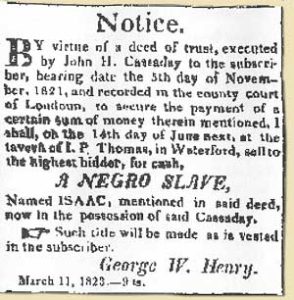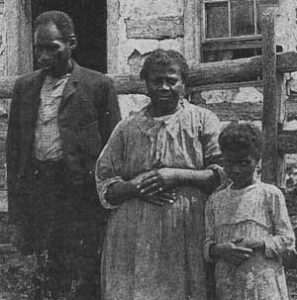ON THIS PAGE
Waterford's African-American Experience & Timeline
Written by Bronwen and John Souders for the Waterford Foundation.
Read African-American recollections of John Divine, a historian who grew up in Waterford »
A simple one-room school, a frame church overlooking a mill, tombstones in a segregated cemetery. These are the most evocative monuments that remain of African-Americans who for 150 years made up a quarter of this old village-and contributed immeasurably to the building, the life, and the character of Waterford. They are all gone now-along with nearly all of the old white families-but their descendants cherish stories of a rich and remarkable past in this unusual Southern town.
1800'S

Mr. Winton Walker and his Second Street School pupils, circa 1920 More »
More on slavery in Waterford »
By the early 1800s, Waterford was home to several free black families. Some owned their own homes. A number learned to read and write in defiance of Virginia laws prohibiting the teaching of African Americans. One, Nathan Minor, was buying' a half quire (12 pages) of writing paper in 1816. In 1854 he wrote out his own will, a rarity for black people of the time. It was witnessed by three white men, two of them Quakers.
Nevertheless, life was rarely easy for African Americans in this southern village. Main Street saw more than one slave auction as men from surrounding farms gathered to buy and sell laborers. But there were also manumissions, and local Quakers campaigned actively for the abolition of slavery.
Working in Waterford
More on working in Waterford »
Meanwhile, through the 19th and 20th centuries, blacks and whites lived and worked closely together. The African-American men and boys plied their crafts and skills as fence builders and farm workers, coopers, millers, tanners, and blacksmiths. Nearly all the black women also worked, as cooks, maids, nurses, and washer-women. (An early resident recalled, smiling, that on washing day, "The bushes were all white with sheets spread out to dry.") Through the years several African Americans served village women of both races as midwives.
While the economic relationship was usually one of black employee and white employer, there were many instances over the years of deep respect and friendship between adults, as well as children, of the two races. And, in contrast with most Loudoun County towns, there was no "black section": Main, Water, High and Janney Streets all had black ownership at one time or another from the early 1800s on.
Segregation
More on segregation in Waterford »
Still, there was segregation. One resident, who lived across from the school for white children, wondered why he had to walk several blocks to the "colored" school. And all children, black and white, while they played with each other and went through each other's kitchen doors, were made to understand when they reached their teen years that they had to associate with their own race. African Americans had their own school from the end of the Civil War until 1957. They built their own church-John Wesley Methodist Episcopal-in 1891 (though both the white and black Methodists had balconies in their churches for visitors of either race). They buried their dead in their own half of the segregated cemetery on Fairfax Street.

African American population of Waterford
At the beginning of the 21s' century, the African-American presence is mostly in memory. As the older generation aged, their children and grandchildren left for opportunity elsewhere. Mary Elizabeth Wallace, the last African American to live here, died in 1999, at 79; Sam Palmer, the final trustee of the John Wesley Church, died in 2001.
The black community continues to look to the village for a sense of family and place. Former residents have generously shared letters, freedom papers and photographs, as well as family records and personal recollections to ensure that this rich history not be lost to the present and future of Waterford and to their descendants.
See also Loudoun County timeline |
|
|
Amos Janney, other Quakers founded Waterford (originally called Janney's Mill)
|
|
|
Declaration of Independence signed; Quakers prohibit members from owning or hiring slaves. |
|
|
William Lane born free in Waterford area. |
|
| Virginia law requires "Free Negroes" and mulattoes to register with town clerk. | |
| Four free black families living in Waterford. | |
| American Colonization Society (ACS) formed to return freed slaves to Africa. | |
| "Free Negro" Nathan Minor buys lot in Waterford. | |
| Nero Lawson buys lot; Waterford Quakers, others form Loudoun County chapter of ACS. | |
| 10 free black families living in Waterford. | |
| African Americans Peter Boggess, Samuel Jackson, Nathan Minor, and James Grimes buy town lots. | |
| Local Quakers found Loudoun Manumission and Emigration Society. | |
|
1830 |
17 free black families living in Waterford. |
|
1831 |
Nat Turner leads bloody slave revolt in southern Virginia. State outlaws the assembling of whites to teach free blacks and slaves to read. |
|
1832 |
Virginia prohibits African Americans from preaching or holding meetings for religious purposes. |
|
1835 |
James Lewis buys town lot. |
|
1850 |
18 free black households in Waterford. |
|
1854 |
Nathan Minor writes his own will. William Robinson purchases the "Weavers Cottage." |
|
1860 |
21 free black household in Waterford; slaves listed separately in the federal census. |
|
1861 |
Waterford votes against secession from the Union 220 to 31, but Virginia joins Confederacy; Civil War begins. |
|
1863 |
Lincoln issues Emancipation Proclamation, authorizes the formation in Massachusetts of the first Negro regiment. |
|
1864 |
Waterford's "Web" Minor serves with Union's Loudoun Rangers, James Lewis with 55th Massachusetts Infantry Regiment, Henson Young with 1st US Colored Infantry. |
|
1867 |
African Americans, Freedmen's Bureau, Quakers build school on Second Street. Reconstruction Act of Congress gives blacks right to vote. |
|
1870 |
Virginia readmitted to the Union. |
|
1873 |
Web Minor buys James Moore House on Big Hill. |
|
1891 |
John Wesley Methodist Episcopal Church constructed; Loudoun Emancipation Society formed in Hamilton. |
|
1896 |
U.S. Supreme Court sanctions "separate but equal" in Plessy v. Ferguson. |
|
1900 |
Noble and Emma Gaither Robinson living at Weavers Cottage with eight children. |
|
1910 |
Waterford's Forest Gaskins serves with 9th US Cavalry (Buffalo Soldiers) at Fort D.A. Russell, Wyoming. |
|
1936 |
Great Depression forces Waterford to give up town charter after 100 years of self-government. |
|
1941 |
U.S. enters World War II; Waterford's African Americans again march off to fight. |
|
1948 |
Former slave Lloyd Curtis dies; African-American Odd Fellows Hall on Big Hill demolished. |
|
1954 |
Supreme Court decision in Brown v. Board of Education leads to eventual school integration. |
|
1957 |
School on Second Street closes; African-American students are bussed to Leesburg. |
|
1968 |
Waterford Elementary School integrated. Segregated Douglass High School in Leesburg closes. Martin Luther King, Jr., assassinated. |
|
1970's |
Final services held at John Wesley Community Church. |
|
1977 |
Waterford Foundation buys school on Second Street. |
|
1984 |
Living history program launched at Second Street School. |
|
1990 |
L. Douglas Wilder elected governor of Virginia, first African-American governor in U.S. |
|
1999 |
Mary Elizabeth Wallace dies at 79, last African-American living in village. Waterford Foundation buys John Wesley church in trust for descendants, |
|
2000 |
Waterford Foundation places preservation easement on John Wesley church. |
|
2001 |
Sam Palmer dies, last trustee of John Wesley church. |
xwx

